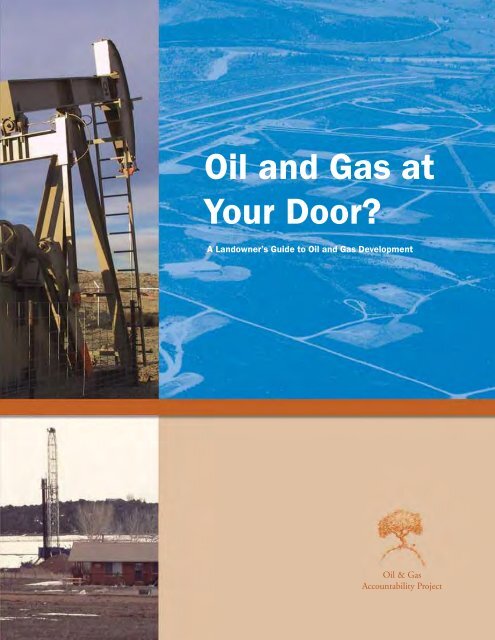Consultant expert, Dr. Mohamed Taha Oil and Gas Development and Impacts
Consultant expert, Dr. Mohamed Taha
Oil and Gas Development and Impacts
OIL & GAS ACCOUNTABILITY PROJECT
Oil and Gas at Your Door?
A Landowner’s Guide to Oil and Gas Development
Second Edition
Chapter I
Oil and Gas Development and Impacts
TERMS AND CONCEPTS
This first section is designed to introduce readers to some key terms and concepts related to
oil and gas.
STAGES OF DEVELOPMENT
The chapter continues with explanations of the various stages involved in oil and gas develop-
ment: from mineral leasing to the abandonment of oil and gas wells. Also included are some of
the issues and impacts associated with these stages of development that may be of concern to
landowners.
DEVELOPMENT OF NONCONVENTIONAL OIL AND GAS
This section introduces readers to the development of various forms of nonconventional oil and
gas. These types of oil and gas deposits are likely to become more heavily exploited in the
future.
IMPACTS OF OIL AND GAS DEVELOPMENT
This section provides information for landowners on some of the potential effects of oil and gas
development on their lands, livelihoods and quality of life.
ALTERNATIVE TECHNOLOGIES—MINIMIZING IMPACTS
The final section provides an overview of some of the “best practices” or alternatives that are
available to companies to minimize the impacts that their operations will have on the environ-
ment and the lives of landowners and nearby residents.
Terms and Concepts
Crude oil is the term for unprocessed oil, and it is also known as petroleum. It is a mixture of
molecules that are composed primarily of hydrogen and carbon atoms (hydrocarbons).
Petroleum got its name from the fact that hydrocarbons are found in rock. The Latin words for
rock and oil are petra and oleum.
Hydrocarbons are formed from dead plant and animal (i.e., organic) matter. Over time, these
materials are covered by layers of sediment. The slow decay of the organic matter, aided by high
temperatures and pressures, completes a long and complex process of transforming the organ-
ic material into hydrocarbons such as coal, oil and natural gas.
We often envision oil and gas reservoirs as being underground lakes of oil capped by natural
gas (which is less dense, and therefore rises above the oil). In reality, oil and gas are most often
located in the pores of rock. The beds of sedimentary rock in which the petroleum is formed are
called the source rocks, and usually these are dark grey or black shales. Because petroleum is
a fluid, it is able to migrate through the earth. Through time, the oil and gas migrate from the
source shales, which are not very porous, into more porous or permeable rocks. Petroleum may
end up in any porous rock, but it is most common to
find large reservoirs of hydrocarbons in highly perme-
able, sedimentary rocks such as sandstone or lime-
stone.
I-1
I
Most people have heard the saying “oil and water do not mix.” When oil and gas encounter
waterlogged formations, the oil and gas, because they are less dense than water, rise all the
way through the water and settle as a layer on its surface. The hydrocarbons continue to move
in an upward direction until they encounter a layer of material that is not porous, i.e., an imper-
meable layer. When this occurs, the oil or gas is said to be trapped. Occasionally, there may be
a pathway (e.g., porous rocks or fractures) that extends all the way to the earth’s surface. If this
occurs (e.g., at a sedimentary rock “outcrop”) hydrocarbons may be found seeping out of the
ground.
Characteristics of Oil and Gas
Crude oil is a mixture of many different hydrocarbon compounds and other materials. Typically,
crude oils contain: carbon (84%); hydrogen (14%); sulfur (1 to 3%); and nitrogen, oxygen, met-
als (e.g., nickel, iron, vanadium, copper, arsenic), and salts (less than 1%). Crude oil is
processed to remove unwanted materials and produce useable “petroleum products” such as
motor gasoline, diesel, jet and home heating fuels, waxes, asphalt, feedstock for petrochemi-
cals, and other components.
The hydrocarbon molecules that make up crude oil can take on many different forms. The small-
est hydrocarbon contains one carbon atom and four hydrogen atoms. It is known as methane
(CH4), and it is lighter than air. Longer chain hydrocarbons, with five or more carbon atoms,
(e.g., pentane, CH5) are liquids. Very long chains are solids like wax or tar.
In general, older and deeper hydrocarbon deposits contain oil that has: 1) low viscosity (which
means it is more liquid than solid); 2) low density (which means it light); and 3) low sulfur con-
tent. These qualities make these old, deep deposits most desirable because they are easy to
extract, they require little refining to remove sulfur
الخبير الاستشاري الدكتور محمد طه
تطوير وتأثيرات النفط والغاز
مشروع محاسبة النفط والغاز
النفط والغاز على بابك؟
دليل مالك الأرض لتطوير النفط والغاز
الطبعة الثانية
الفصل الأول
تطوير وتأثيرات النفط والغاز
الشروط والمفاهيم
تم تصميم هذا القسم الأول لتعريف القراء ببعض المصطلحات والمفاهيم الأساسية المتعلقة بها
النفط والغاز.
مراحل التنمية
يتابع الفصل شرح المراحل المختلفة التي ينطوي عليها تطوير النفط والغاز-
منة: من تأجير المعادن إلى التخلي عن آبار النفط والغاز. وشملت أيضا هي بعض من
القضايا والآثار المرتبطة بمراحل التطوير هذه والتي قد تكون موضع اهتمام
ملاك الأراضي.
تطوير النفط والغاز غير التقليديين
يقدم هذا القسم للقراء كيفية تطوير أشكال مختلفة من الزيوت غير التقليدية و
غاز. من المحتمل أن يتم استغلال هذه الأنواع من رواسب النفط والغاز بشكل كبير في
مستقبل.
آثار تطوير النفط والغاز
يقدم هذا القسم معلومات لملاك الأراضي حول بعض الآثار المحتملة للنفط والغاز
على أراضيهم وسبل عيشهم ونوعية حياتهم.
تقنيات بديلة - تقليل الآثار
يقدم القسم الأخير نظرة عامة على بعض "أفضل الممارسات" أو البدائل
المتاحة للشركات لتقليل الآثار التي ستحدثها عملياتها على البيئة-
منة وحياة أصحاب الأراضي والسكان القريبين.
الشروط والمفاهيم
النفط الخام هو مصطلح يطلق على النفط غير المعالج ، ويُعرف أيضًا باسم البترول. إنها خليط من
الجزيئات التي تتكون أساسًا من ذرات الهيدروجين والكربون (الهيدروكربونات).
حصل البترول على اسمه من حقيقة وجود الهيدروكربونات في الصخور. الكلمات اللاتينية ل
الصخور والنفط هي البتراء والزيت.
تتكون الهيدروكربونات من مواد نباتية وحيوانية (أي عضوية) ميتة. بمرور الوقت ، هذه
المواد مغطاة بطبقات من الرواسب. الاضمحلال البطيء للمادة العضوية مدعوم بالارتفاع
درجات الحرارة والضغط ، يكمل عملية طويلة ومعقدة لتحويل العضو-
تحويل المواد IC إلى مواد هيدروكربونية مثل الفحم والنفط والغاز الطبيعي.
غالبًا ما نتصور خزانات النفط والغاز على أنها بحيرات نفط جوفية يكسوها النفط الطبيعي
الغاز (وهو أقل كثافة وبالتالي يرتفع فوق الزيت). في الواقع ، غالبًا ما يكون النفط والغاز
تقع في مسام الصخور. تتكون طبقات الصخور الرسوبية التي يتكون فيها البترول
تسمى صخور المصدر ، وعادة ما تكون صخرية رمادية داكنة أو سوداء. لأن البترول
سائل قادر على الهجرة عبر الأرض. بمرور الوقت ، يهاجر النفط والغاز من
مصدر الصخر الزيتي ، الذي ليس مساميًا جدًا ، يتحول إلى صخور مسامية أو قابلة للاختراق. يجوز للبترول
ينتهي به الأمر في أي صخرة مسامية ، لكنها الأكثر شيوعًا
العثور على خزانات كبيرة من الهيدروكربونات في درجة نفاذية عالية-
الصخور الرسوبية القادرة مثل الحجر الرملي أو الجير-
حجر.
أنا -1
أنا
لقد سمع معظم الناس مقولة "الزيت والماء لا يختلطان". عندما يلتقي النفط والغاز
التكوينات المشبعة بالمياه ، النفط والغاز ، لأنها أقل كثافة من الماء ، ترتفع كل
طريقه من خلال الماء ويستقر كطبقة على سطحه. تستمر الهيدروكربونات في التحرك
في اتجاه تصاعدي حتى يواجهوا طبقة من المواد غير المسامية ، أي ضرورة-
طبقة ميبل. عندما يحدث هذا ، يقال إن النفط أو الغاز محاصران. من حين لآخر ، قد يكون هناك
مسار (على سبيل المثال ، الصخور المسامية أو الكسور) الذي يمتد على طول الطريق إلى سطح الأرض. اذا هذا
يحدث (على سبيل المثال ، عند "نتوء" صخر رسوبي) يمكن العثور على هيدروكربونات تتسرب من
أرضي.
خصائص النفط والغاز
النفط الخام هو مزيج من العديد من المركبات الهيدروكربونية المختلفة والمواد الأخرى. عادة،
تحتوي الزيوت الخام على: الكربون (84٪) ؛ الهيدروجين (14٪) ؛ الكبريت (1 إلى 3٪) ؛ والنيتروجين والأكسجين
كذلك (مثل النيكل والحديد والفاناديوم والنحاس والزرنيخ) والأملاح (أقل من 1٪). النفط الخام
معالجتها لإزالة المواد غير المرغوب فيها وإنتاج "منتجات بترولية" قابلة للاستخدام مثل
بنزين المحركات والديزل ووقود التدفئة المنزلية والشمع والأسفلت والمواد الأولية للبتروكيماويات-
السعرات الحرارية والمكونات الأخرى.
يمكن أن تتخذ جزيئات الهيدروكربون التي يتكون منها النفط الخام أشكالًا مختلفة. الصغير-
يحتوي الهيدروكربونات على ذرة كربون واحدة وأربع ذرات هيدروجين. ومن المعروف باسم الميثان
(CH4) ، وهو أخف من الهواء. هيدروكربونات أطول سلسلة ، مع خمس ذرات كربون أو أكثر ،
(على سبيل المثال ، البنتان ، CH5) عبارة عن سوائل. السلاسل الطويلة جدًا هي مواد صلبة مثل الشمع أو القطران.
بشكل عام ، تحتوي رواسب الهيدروكربون الأقدم والأعمق على زيت يحتوي على: 1) لزوجة منخفضة (أي
يعني أنه سائل أكثر من صلب) ؛ 2) كثافة منخفضة (مما يعني أنها خفيفة) ؛ و 3) انخفاض محتوى الكبريت
خيمة. هذه الصفات تجعل هذه الرواسب القديمة والعميقة مرغوبة أكثر لأنها سهلة
المستخلص ، فإنها تتطلب القليل من التكرير لإزالة الكبريت




